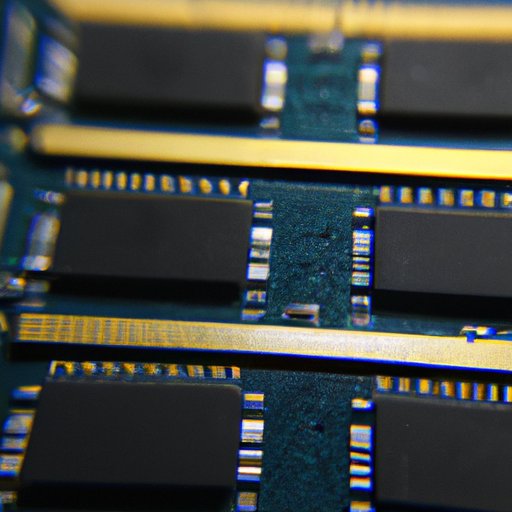
Introduction
Checking your computer’s RAM may seem unnecessary to some users. However, keeping track of your device’s RAM size can help you troubleshoot performance issues and make informed decisions when upgrading your hardware. In this article, we will explain how to check how much RAM you have in your device, and provide you with several easy tricks to find RAM information quickly.
A Step-by-Step Guide to Checking Your Computer’s RAM
If you prefer an in-depth guide, this section is for you. Here are the steps you need to follow to check RAM information:
Step 1: Identifying Your Operating System
Depending on your operating system, the tools and tricks you use to check RAM can vary. Most users will have either Windows or Mac OS. You should determine which operating system you have before you start.
Step 2: Accessing the System Information Tool
The System Information tool displays detailed information about your computer’s hardware and software, including the amount of memory installed on your device. To access this tool on a Windows PC, press the Windows key + R and type “msinfo32” in the Run dialog box. To access System Information on a Mac, click on the Apple icon on the top left corner, select “About This Mac,” and then click on “System Report.”
Step 3: Finding the RAM Information
Once you open the System Information tool, look for “Installed Physical Memory” or “Total Memory” under the “System Summary” section for a Windows PC. On a Mac, click on “Memory” under the “Hardware” section.
3 Easy Tricks to Find Out How Much RAM is in Your Device
If you prefer a shortcut, try using these three easy tricks:
Trick 1: Using Task Manager (for Windows users)
Press Ctrl + Shift + Esc to open the Task Manager, then click on the “Performance” tab. You will find the amount of memory displayed under “Memory.”
Trick 2: Using Activity Monitor (for Mac users)
Search for “Activity Monitor” in Spotlight, then click on the “Memory” tab. You will find the amount of memory displayed at the bottom of the window.
Trick 3: Using Command Prompt (for both Windows and Mac users)
Open Command Prompt and type “wmic MemoryChip get Capacity” to find the total amount of installed RAM. Alternatively, type “system_profiler SPHardwareDataType” on a Mac to find memory information, including total memory.
RAM Check: The Ultimate How-To Guide for Windows and Mac Users
If you are looking for a more detailed guide, this section is for you. Here are the step-by-step instructions on how to check RAM for Windows and Mac users:
Windows Users
- Open System Information by typing “msinfo32” in the Run dialog box.
- Look for “Installed Physical Memory” or “Total Memory” under the “System Summary” section.
- Check the Task Manager. Press Ctrl + Shift + Esc to open the Task Manager, then click on the “Performance” tab. You will find the amount of memory displayed under “Memory.”
- Use Command Prompt by typing “wmic MemoryChip get Capacity.”
Mac Users
- Click on the Apple logo on the top left corner, select “About This Mac,” and then click on “System Report.”
- Click on “Memory” under the “Hardware” section.
- Check the Activity Monitor. Search for “Activity Monitor” in Spotlight, then click on the “Memory” tab. You will find the amount of memory displayed at the bottom of the window.
- Use Command Prompt by typing “system_profiler SPHardwareDataType.”
Take Control of Your Device’s Performance with These Simple RAM Checking Tips
RAM plays a crucial role in your device’s performance. Here are some tips on how to identify when to check RAM, and what to do with the information you gather:
- Check RAM regularly: Check your device’s RAM size every few months, especially if you notice any performance issues.
- Upgrade your hardware: If you have less than 8GB of RAM, consider upgrading your device’s memory for better performance.
- Close unnecessary programs: If your device seems slow, close any unnecessary programs to free up RAM.
How to Determine Your Computer’s RAM Size in Minutes: An Efficient User’s Guide
This article provided you with plenty of tips and tricks to check your device’s RAM. Here is a quick recap of what you need to know:
- To check RAM on a Windows PC, use the System Information tool, Task Manager, or Command Prompt.
- To check RAM on a Mac, use the System Information tool, Activity Monitor, or Command Prompt.
- Check your device’s RAM regularly, and upgrade your hardware if necessary.
Conclusion
Now that you know how to check how much RAM you have in your device, take control of your device’s performance by monitoring its memory. Checking your device’s RAM can help you identify any performance issues and make informed decisions when upgrading your hardware. Hopefully, this article provided you with all the information you need to determine your computer’s RAM size quickly and efficiently.
Don’t hesitate to give it a try and let us know how it goes.




